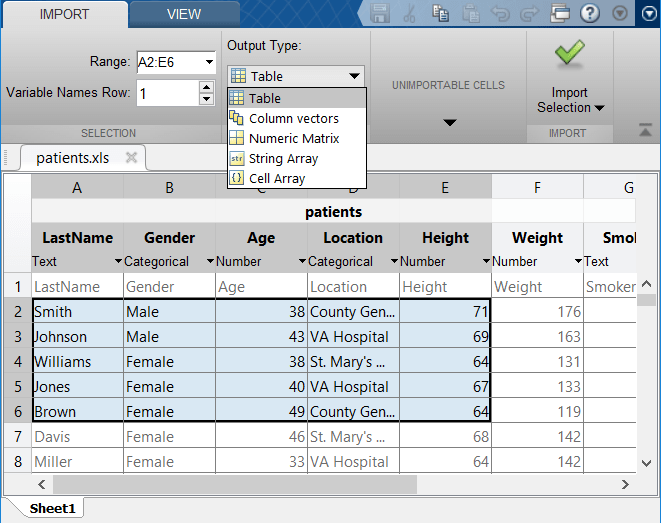导入电子表格
电子表格,(如 Microsoft® Excel® 文件)通常包含数值和文本数据以及变量名称和行名称的混合。在 MATLAB® 中表示电子表格数据的最常见方式是使用表,但您也可以在 MATLAB 中将电子表格数据表示为时间表、矩阵或元胞数组。
以编程方式或以交互方式从电子表格导入数据。以编程方式导入以使用定制的导入函数,并进一步控制如何使用导入选项导入数据。使用导入工具以交互方式导入。
以表的形式导入数据
您可以将电子表格数据作为表导入。一个表由若干列向变量组成,每个变量包含相同类型的数据。表中的变量可以保留不同数据类型和大小,但每个变量必须有相同的行数。有关表的详细信息,请参阅创建表并为其分配数据。
使用 readtable 函数将表格数据从电子表格导入表中。例如,根据示例文件 patients.xls 创建一个表。显示表的前五行和前五列。
T = readtable("patients.xls");
T(1:5,1:5)ans =
5×5 table
LastName Gender Age Location Height
____________ __________ ___ _____________________________ ______
{'Smith' } {'Male' } 38 {'County General Hospital' } 71
{'Johnson' } {'Male' } 43 {'VA Hospital' } 69
{'Williams'} {'Female'} 38 {'St. Mary's Medical Center'} 64
{'Jones' } {'Female'} 40 {'VA Hospital' } 67
{'Brown' } {'Female'} 49 {'County General Hospital' } 64 将数据以时间表形式导入
如果电子表格的行与时间相关联,您可以将数据作为时间表导入。与表一样,时间表允许您存储表格数据变量,这些变量可以有不同数据类型和大小,只要它们有相同的行数。此外,时间表还提供特定于时间的函数,以便使用一个或多个时间表中的时间戳数据执行对齐、组合和计算。有关时间表的详细信息,请参阅创建时间表。
使用 readtimetable 函数将电子表格中的表格数据导入时间表。例如,从示例文件 sample.xls 创建一个时间表。显示时间表的前五行和前五列。
TT = readtimetable("sample.xls");
TT(1:5,1:5)ans =
5×5 timetable
OutageTime Region Loss Customers RestorationTime Cause
________________ _____________ ______ __________ ________________ ___________________
2002-02-01 12:18 {'SouthWest'} 458.98 1.8202e+06 2002-02-07 16:50 {'winter storm' }
2003-01-23 00:49 {'SouthEast'} 530.14 2.1204e+05 NaT {'winter storm' }
2003-02-07 21:15 {'SouthEast'} 289.4 1.4294e+05 2003-02-17 08:14 {'winter storm' }
2004-04-06 05:44 {'West' } 434.81 3.4037e+05 2004-04-06 06:10 {'equipment fault'}
2002-03-16 06:18 {'MidWest' } 186.44 2.1275e+05 2002-03-18 23:23 {'severe storm' }
以矩阵的形式导入数据
如果您的电子表格文件包含统一的数据(均为同一类型),您可以将数据以矩阵的形式导入。通过将数据导入矩阵中,您可以处理具有最基本格式的数组。
使用 readmatrix 将电子表格文件中的均匀数据导入矩阵。例如,基于示例文件 basic_matrix.xls 创建一个矩阵。
M = readmatrix("basic_matrix.xls")
M = 5×4
6 8 3 1
5 4 7 3
1 6 7 10
4 2 8 2
2 7 5 9将数据以元胞数组的形式导入
元胞数组是一种包含名为元胞的索引数据容器的数据类型,其中的每个元胞都可以包含任意类型的数据。元胞数组通常包含文本列表、文本和数字的组合或者不同大小的数值数组。
使用 readcell 将电子表格中的非均匀数据(混合类型的数据)导入元胞数组中。例如,基于 basic_cell.xls 中的非均匀数据创建一个元胞数组。
C = readcell("basic_cell.xls")C = 3×3 cell array
{[ 1]} {[ 2]} {[ 3]}
{'hello' } {'world'} {[ NaN]}
{[10-Oct-2018 10:27:56]} {[ 1]} {1x1 missing}使用导入选项导入数据以进行更多控制
导入电子表格数据有时需要对导入过程进行更多控制。要自定义导入过程,您可以创建导入选项对象。该对象具有您可以根据自己的导入需求进行调整的属性。例如,您可以更改变量的数据类型或仅导入变量的子集。有关导入选项的详细信息,请参阅 detectImportOptions。
以交互方式导入数据
您可以使用导入工具以交互方式将数据导入表或其他数据类型。
要打开导入工具,请在主页选项卡中的变量部分中,点击导入数据  。然后,选择要导入的文件。或者,在“文件”面板中右键点击文件名,然后选择导入数据。使用导入工具窗口,设置导入选项,然后点击导入所选内容
。然后,选择要导入的文件。或者,在“文件”面板中右键点击文件名,然后选择导入数据。使用导入工具窗口,设置导入选项,然后点击导入所选内容  ,将数据导入 MATLAB。有关详细信息,请参阅使用导入工具读取电子表格数据。
,将数据导入 MATLAB。有关详细信息,请参阅使用导入工具读取电子表格数据。
例如,根据示例电子表格文件 patients.xls 创建一个表。使用导入工具打开该文件,并选择数据范围和输出类型等选项。然后,点击导入所选内容  ,将数据作为表导入 MATLAB 工作区。
,将数据作为表导入 MATLAB 工作区。
